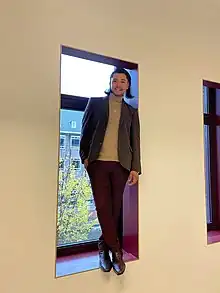Adam Castillejo
Adam Castillejo, also known as "The London Patient",[1] is the second person known to have been cured of HIV infection. [3] [4][5] Castillejo, who is British-Venezuelan.[2] and has mixed European ancestry, lives in London. He has previously worked as a chef [6] and is now a motivational speaker.
Adam Castillejo | |
|---|---|
 | |
| Born | 1979 or 1980 (age 43–44)[1] Venezuela[2] |
| Other names | The London Patient |
| Known for | Second person known to have been cured of HIV infection |
His body became resistant to HIV infection after receiving a bone marrow transplant in 2016[7] to treat Hodgkin's lymphoma. The German donor carried the CCR5-Δ32 mutation which gives resistance from HIV infection.[8] It is likely because of his half-Dutch father that Adam’s donor was compatible with him. He was treated by Professor Ravindra Gupta.[5]
See also
References
- Mandavilli, Apoorva (9 March 2020). "The 'London Patient,' Cured of H.I.V., Reveals His Identity". The New York Times. Retrieved 29 January 2022.
- Mouzo, Jessica (22 February 2023). "The London Patient: 'I feel like I won the lottery: I have been cured of two incurable diseases'". EL PAÍS English Edition. Retrieved 23 February 2023.
- Gupta, Ravindra (10 March 2020). "Evidence for HIV-1 cure after CCR5Δ32/Δ32 allogeneic haemopoietic stem-cell transplantation 30 months post analytical treatment interruption: a case report". The Lancet.
- Davis, Nicola (9 March 2020). "Second person ever to be cleared of HIV reveals identity". The Guardian. Archived from the original on 9 March 2020. Retrieved 10 March 2020.
- "Cured of HIV: I want to be an ambassador of hope". BBC News. Retrieved 7 February 2021.
- "Hospitality Action". www.hospitalityaction.org.uk. Retrieved 20 July 2023.
- Mandavilli, Apoorva (9 March 2020). "The 'London Patient,' Cured of H.I.V., Reveals His Identity". The New York Times. ISSN 0362-4331. Retrieved 23 February 2023.
- Apoorva Mandavilli (4 March 2019). "H.I.V. Is Reported Cured in a Second Patient, a Milestone in the Global AIDS Epidemic". The New York Times. Archived from the original on 24 May 2019. Retrieved 4 March 2019.
This article is issued from Wikipedia. The text is licensed under Creative Commons - Attribution - Sharealike. Additional terms may apply for the media files.
